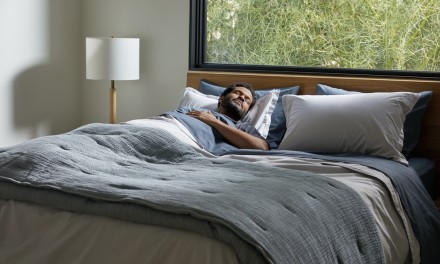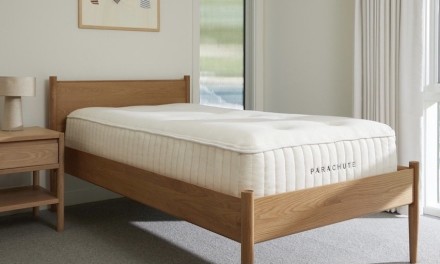Whether you have a hard time falling asleep with disruptive background noises or can't doze off in complete silence, white noise might help. But what is white noise sound exactly, and how does it work?
This article has all the white noise information you need, including how this sound frequency works, why it can induce sleep and tips for buying a white noise machine.
What Is White Noise?
White noise is a mix of sounds containing all frequencies people can hear. There are 20,000 frequencies audible to human ears, ranging from the lowest base notes to the highest pitches, and it plays them all at once. It's called "white" noise because white light comprises all frequencies of light.
What Are White Noises?
White noises are sounds featuring all 20,000 audible frequencies equally, meaning the low tones are just as intense as the high ones. Sometimes called broadband noises or broadcasting noises, they're reminiscent of TV static or an untuned radio. White noise can also sound like a vacuum cleaner.
White vs. Pink vs. Brown Noise
What is the difference between white noise, brown noise and pink noise? To untrained ears, these sounds might be indistinguishable because they're all non-musical ambient noises. However, each of these types of noise is unique.
White Noise
White noise contains all the tones audible to the human ear. Though it can effectively mask other sounds and may help with sleep, some people find the higher pitches unpleasant.
Pink Noise
Pink noise also features all sounds people can hear. But unlike white noise, the higher frequencies are reduced and the lower ones are amplified. Read our article What is Pink Noise? for more info on why this sound is so great for sleep.
Brown Noise
Like its white and pink counterparts, brown noise (or red noise) contains all audible sounds. The difference is that the lowest base notes are the strongest (even stronger than with pink noise), and the highest pitches are virtually unnoticeable. Folks with tinnitus who are particularly sensitive to high-pitched sounds may prefer brown noise to other auditory colors.
What Is White Noise?
White noise is a mix of sounds containing all frequencies people can hear. There are 20,000 frequencies audible to human ears, ranging from the lowest base notes to the highest pitches, and it plays them all at once. It's called "white" noise because white light comprises all frequencies of light.
What Are White Noises?
White noises are sounds featuring all 20,000 audible frequencies equally, meaning the low tones are just as intense as the high ones. Sometimes called broadband noises or broadcasting noises, they're reminiscent of TV static or an untuned radio. White noise can also sound like a vacuum cleaner.
White vs. Pink vs. Brown Noise
What is the difference between white noise, brown noise and pink noise? To untrained ears, these sounds might be indistinguishable because they're all non-musical ambient noises. However, each of these types of noise is unique.
White Noise
White noise contains all the tones audible to the human ear. Though it can effectively mask other sounds and may help with sleep, some people find the higher pitches unpleasant.
Pink Noise
Pink noise also features all sounds people can hear. But unlike white noise, the higher frequencies are reduced and the lower ones are amplified. Read our article What is Pink Noise? for more info on why this sound is so great for sleep.
Brown Noise
Like its white and pink counterparts, brown noise (or red noise) contains all audible sounds. The difference is that the lowest base notes are the strongest (even stronger than with pink noise), and the highest pitches are virtually unnoticeable. Folks with tinnitus who are particularly sensitive to high-pitched sounds may prefer brown noise to other auditory colors.
Does White Noise Help You Sleep?
White noise helps cancel out unwanted background sounds, like barking dogs or honking car horns. As a result, it can help people of all ages doze off faster and may help light sleepers get the shut-eye they need. One study found that adults fell asleep faster by about 40% when listening to white noise.
Does White Noise Help You Sleep?
White noise helps cancel out unwanted background sounds, like barking dogs or honking car horns. As a result, it can help people of all ages doze off faster and may help light sleepers get the shut-eye they need. One study found that adults fell asleep faster by about 40% when listening to white noise.
What is white noise for a baby? Infants are used to hearing sounds from inside the womb. Research shows that white noise machines mimicking these sounds help newborns fall asleep faster, sleep more and cry less. This is why many babies are soothed with a "shushing" sound.
What Is a White Noise Machine?
A white noise machine is a device that plays non-musical sounds through a speaker, such as a flowing waterfall or a trickling creek. The sounds can also be more ambiguous, like a vague rushing noise. These machines can be portable, with replaceable or rechargeable batteries, or can plug into a wall.
How to Choose a White Noise Machine
You can buy white noise machines online, at big-box stores and at specialty shops that carry sleep gadgets and wellness products. There are wallet-friendly options for under $20 and higher-end designs that cost upwards of $100.
Though a higher price could indicate a better-quality machine, the most important thing is the sounds it plays (and how your ears respond to them). Many devices have pink and brown noises along with white, but since most people aren't familiar with the differences between these sleep sounds, they're still usually sold as "white noise" machines.
Beyond that, you'll want to consider portability. Do you need something small and rechargeable for traveling, or will a plug-in model suffice? Other features to look for are volume controls and a sleep timer.
What Is a White Noise Machine?
A white noise machine is a device that plays non-musical sounds through a speaker, such as a flowing waterfall or a trickling creek. The sounds can also be more ambiguous, like a vague rushing noise. These machines can be portable, with replaceable or rechargeable batteries, or can plug into a wall.
How to Choose a White Noise Machine
You can buy white noise machines online, at big-box stores and at specialty shops that carry sleep gadgets and wellness products. There are wallet-friendly options for under $20 and higher-end designs that cost upwards of $100.
Though a higher price could indicate a better-quality machine, the most important thing is the sounds it plays (and how your ears respond to them). Many devices have pink and brown noises along with white, but since most people aren't familiar with the differences between these sleep sounds, they're still usually sold as "white noise" machines.
Beyond that, you'll want to consider portability. Do you need something small and rechargeable for traveling, or will a plug-in model suffice? Other features to look for are volume controls and a sleep timer.
How to Get White Noise on Your Phone
A noise machine isn't your only option. Countless white noise mobile apps allow you to listen to soothing frequencies from anywhere. You can also search for white (or pink or brown) noise on a music app, like Spotify, SoundCloud or Apple Music. YouTube is another great resource.
Aside from smartphone apps, brown noise sound therapy tracks are available for download from the American Tinnitus Association.
How to Get White Noise on Your Phone
A noise machine isn't your only option. Countless white noise mobile apps allow you to listen to soothing frequencies from anywhere. You can also search for white (or pink or brown) noise on a music app, like Spotify, SoundCloud or Apple Music. YouTube is another great resource.
Aside from smartphone apps, brown noise sound therapy tracks are available for download from the American Tinnitus Association.
Tips for Incorporating White Noise Into Your Bedtime Routine
High-quality sleep is vital for mental and physical wellness. Listening to white noise can help you fall asleep quicker, but it's just one component of a healthy bedtime routine.
Try going to bed at roughly the same time every night and getting up at the same time each morning — yep, even on the weekends. Keep your bedroom as dark as possible by turning off all electronics and using blackout curtains. Also, try not to use your phone about an hour or so before turning in, to avoid stimulating blue light.
Another thing to note is that not all frequencies are created equal — and everyone has different preferences. While some auditory colors help people go to sleep faster and achieve deeper sleep, certain pitches could actually make it harder to sleep.
Some folks find white noise too high-pitched to be soothing. If you're one of them, you might find white or brown noise more calming.
After turning on your noise machine, set a sleep timer if you need to, and adjust the volume. Listening to any sound too loud can damage your hearing, especially if you're using headphones.
Changing the clocks can also help or hinder sleep. See our blog about Daylight Savings Ending to find out if the bi-annual time change could be over for good soon.
Tips for Incorporating White Noise Into Your Bedtime Routine
High-quality sleep is vital for mental and physical wellness. Listening to white noise can help you fall asleep quicker, but it's just one component of a healthy bedtime routine.
Try going to bed at roughly the same time every night and getting up at the same time each morning — yep, even on the weekends. Keep your bedroom as dark as possible by turning off all electronics and using blackout curtains. Also, try not to use your phone about an hour or so before turning in, to avoid stimulating blue light.
Another thing to note is that not all frequencies are created equal — and everyone has different preferences. While some auditory colors help people go to sleep faster and achieve deeper sleep, certain pitches could actually make it harder to sleep.
Some folks find white noise too high-pitched to be soothing. If you're one of them, you might find white or brown noise more calming.
After turning on your noise machine, set a sleep timer if you need to, and adjust the volume. Listening to any sound too loud can damage your hearing, especially if you're using headphones.
Changing the clocks can also help or hinder sleep. See our blog about Daylight Savings Ending to find out if the bi-annual time change could be over for good soon.
White Noise FAQ
Find answers to frequently asked questions about white noise below.
White Noise FAQ
Find answers to frequently asked questions about white noise below.
What does white noise do?
White noise helps some people fall asleep and stay asleep. It works by essentially blocking out unpleasant external sounds, like noisy neighbors, loud roommates, honking cars or barking dogs.
What is an example of a white noise?
A few examples of white noise include TV static, a running vacuum, a humming refrigerator, a whirring fan or an idling car engine.
Is it OK to play white noise all night?
Generally speaking, it's OK to play white noise all night. Though it may help you fall asleep and potentially sleep deeper by canceling out external sounds, be sure to choose a sound you find particularly calming. Also, make sure the volume isn't too high to avoid damaging your hearing.
High-Quality Sleep Essentials From Parachute
Parachute has all the bedroom must-haves for upgrading your sleeping quarters, including a universally comfy mattress, bed pillows for every sleeping position and naturally sourced bedding. Explore the collections today!
External Sources:
Barozzi S, et al. Effects of tinnitus retraining therapy with different colors of sound. The International Tinnitus Journal. 2017. doi: 10.5935/0946-5448.20170026.
Messineo L, et al. Broadband Sound Administration Improves Sleep Onset Latency in Healthy Subjects in a Model of Transient Insomnia. Frontiers in Neurology. 2017. doi.org/10.3389/fneur.2017.00718
Ebben MR, Yan P, Krieger AC. The effects of white noise on sleep and duration in individuals living in a high noise environment in New York City. Sleep Med. 202. doi: 10.1016/j.sleep.2021.03.031.
UPMC Children's Hospital of Pittsburgh. Benefits of White Noise for Babies. 2022. Web.
Worley SL. The Extraordinary Importance of Sleep: The Detrimental Effects of Inadequate Sleep on Health and Public Safety Drive an Explosion of Sleep Research. P T. 2018.
National Institute on Deafness and Other Communication Disorders. Noise-Induced Hearing Loss. National Institute of Health (NIH). 2022. Web.
Papalambros NA, et al. Acoustic Enhancement of Sleep Slow Oscillations and Concomitant Memory Improvement in Older Adults. Frontiers in Human Neuroscience. 2017. doi.org/10.3389/fnhum.2017.00109
High-Quality Sleep Essentials From Parachute
Parachute has all the bedroom must-haves for upgrading your sleeping quarters, including a universally comfy mattress, bed pillows for every sleeping position and naturally sourced bedding. Explore the collections today!
External Sources:
Barozzi S, et al. Effects of tinnitus retraining therapy with different colors of sound. The International Tinnitus Journal. 2017. doi: 10.5935/0946-5448.20170026.
Messineo L, et al. Broadband Sound Administration Improves Sleep Onset Latency in Healthy Subjects in a Model of Transient Insomnia. Frontiers in Neurology. 2017. doi.org/10.3389/fneur.2017.00718
Ebben MR, Yan P, Krieger AC. The effects of white noise on sleep and duration in individuals living in a high noise environment in New York City. Sleep Med. 202. doi: 10.1016/j.sleep.2021.03.031.
UPMC Children's Hospital of Pittsburgh. Benefits of White Noise for Babies. 2022. Web.
Worley SL. The Extraordinary Importance of Sleep: The Detrimental Effects of Inadequate Sleep on Health and Public Safety Drive an Explosion of Sleep Research. P T. 2018.
National Institute on Deafness and Other Communication Disorders. Noise-Induced Hearing Loss. National Institute of Health (NIH). 2022. Web.
Papalambros NA, et al. Acoustic Enhancement of Sleep Slow Oscillations and Concomitant Memory Improvement in Older Adults. Frontiers in Human Neuroscience. 2017. doi.org/10.3389/fnhum.2017.00109







